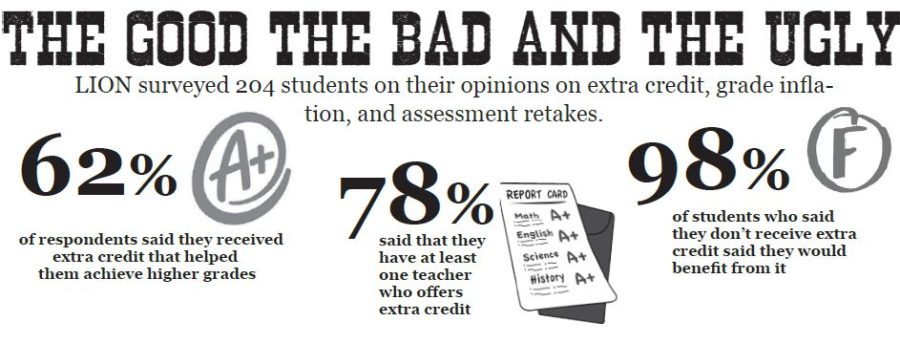Grade Inflation: Point-Counterpoint-Counterpoint (video/article)
December 3, 2018
Test-retakes, Curves and Extra credit is a staple of high achieving classrooms. Students love it. But is it actually helping students master the subject matter? That is the question on this issue of Point Counterpoint Counterpoint. You can watch a video of this debate bellow. Or, you can watch the video in a new tab on LTTV’s YouTube Account.
Point: Throw me a Curve
by Diane Makovic
Grade inflation is necessary. Students strive to do well in school, but we all have a class or unit that doesn’t stick. Grade inflation allows students to improve their grades, while still enforcing the mastery and understanding of topics.
Curving can be beneficial to students on tests that include unclear questions or information that hasn’t been taught. Curves help to maintain grades, instead of penalizing prepared students for a question that was poorly written. One teacher’s history test might be harder than another’s, which is unfair for students who learned the same information. This is where grade inflation comes in. Curves help to provide a more accurate representation of what a student knows and can help to standardize scores across classes.
There are different methods of grade inflation, including test curves and extra credit opportunities. Some teachers curve by rounding the highest (or second highest) score up to 100 percent, and scale each following grade accordingly. If the highest grade in the class is an 85 percent, then the teacher can curve the grades up each 15 percent . The teacher can look at the trends in the scores to see what they should reteach to the class or correct for future classes.
For example, in AP physics at LT, tests are curved and extra points are available (called “corrective quizzes”). The week after the test, a correctives quiz is given where students can earn points back on their tests. These quizzes are based off of the most frequently missed test questions. This is beneficial because it reinforces important topics and allows students to relearn and show mastery of information they may have been unclear on in the past.
Achieving mastery of a topic is especially important in an AP class, since the AP tests in May cover the information learned throughout the entire year. Many topics build off of each other, especially in math classes. Not understanding one unit can come back to hurt you in following units. Retakes and extra credit provide motivation to students to come in and ask for help to make sure that they understand the topic to gain the extra points.
Curves can be helpful in challenging courses, such as AP classes. These classes and tests are rigorous and meant to prepare you for college and the AP exam. Having grade inflation in place allows students to have a buffer in challenging classes.
While some may argue that grade inflation gives out too many unearned As, I believe that grade inflation allows students to showcase mastery and provide standardization between classes. Retakes allow for second chances. They can also penalize you for not getting the best grade the first time because retakes are not curved. In some classes, retakes are not a “take the higher grade” situation. You have to commit to the new grade, whether it’s better or worse. This teaches accountability and responsibility because you are held accountable for the newest grade.
Students who perform poorly on one test can often have a difficult time raising their grade. Grade inflation can assist by providing alternate opportunities for students to gain back points. Extra credit allows students to demonstrate further comprehension and improve their grade.
Grade inflation is beneficial and fair because it allows for mastery of a topic; no one is perfect on the first attempt every time.
Counterpoint: Your fave is problematic
by Olivia Janik
Inflated grades are great. They boost scores in hard classes, encourage hard work and allow students to learn from their mistakes. At least that’s how it seems, but every student’s favorite grading policy isn’t all it’s cracked up to be.
Inflated grades promote academic inequality. Grade inflation can’t be monitored from school to school or even class to class; this means that students are compared to each other on an unbalanced scale. There’s no way to regulate how each teacher in each school across the country inflates their students grades. Each teacher has their own system for how they hand out extra credit, give retakes, or give points back on tests. For example, how grades are inflated in LT’s physics classes will be completely different from how grades are inflated in the same class at Hinsdale South. This becomes a problem when these students are applying to the same college; grade inflation may give the student who had curves on their tests an unfair advantage against a student who didn’t get the curve or didn’t have extra credit assignments. Overall, grade inflation creates a problem called the GPA gap.
The GPA gap occurs when schools inflate grades at a higher rate than other schools, producing a large amount of unearned As. This system gives some students an unfair advantage against students who attend schools that don’t inflate grades. Grade inflation undermines the hard work that some students put into their grades. Students who put an incredible amount of effort into their schoolwork are treated the same as students who put a medium amount of work into their grades, but curves and extra credit allow them to get ahead in high school and college.
When the data was analyzed by Michael Hurwitz, a member of the College Board and Jason Lee, a doctorate student from University of Georgia, they found that grade inflation is found at much higher rate in wealthier, white neighborhoods. Private schools inflate grades at three times the amount public schools do. All of these factors lead to unequal opportunity when students apply to college.
Some people will argue that there are so many factors that weigh into students’ grades, so grade inflation doesn’t matter at the end of the line. The truth is, grade inflation does matter. It unjustly advances students from private schools and wealthy backgrounds. Grade inflation may only be one factor that contributes to GPA, but it’s a factor that promotes inequality. Keeping grade inflation in place only hurts the students who it don’t receive it, while unjustly benefiting the ones that do.
I do understand that this is hypocritical coming from a student who takes advantage of retakes and extra credit. However, morality should come first. There are some things that are more important in life than getting an A thanks to 13-point curves and taking copious amounts of retakes. Protecting the American value of equal opportunity should be one of them.
Counter-point: Extra Credit (Should)=Extra help
by Hayden Claesson
Getting an A in a class should be an impressive feat. Earning that grade should represent that the student has near mastery of the subject material taught to them. However, it isn’t that simple. There are a lot more factors that go into getting a good grade in a class than simply understanding the class material. One of these factors is just how many points are available for students to earn. This is where controversy of extra credit and curving text scores comes in.
As I have said before, my belief in grades is that a student’s grade should represent how well they have mastered the subject material. That being said, I think extra credit assignments that further a student’s ability to be better at the subject are beneficial. A great example of this is test retakes and correctives. If a student takes a test and gets a bad grade, these offer students a way to learn from their mistakes and have a shot at redemption and get extra practice on a subject they may be struggling with. The idea of having students do extra practice while also giving them the incentives of getting points back is great and benefits both the student and the teacher. Test retakes are a great thing that teachers do in order to make sure students, especially ones in AP classes, are able to understand what they are learning so that the student can know the subject material better for AP exams in the spring.
While I love some types of extra credit, sometimes it just simply does not make sense. Offering students points for miniscule assignments that really don’t reinforce their education are not benefiting the students’ learning experience. The idea of throwing free points at students for doing something that does not help them with what they are learning is just silly.
Another part of grade inflation I have an issue with is curving tests. Don’t get me wrong, as a student I love getting a test back with a 95-percent when I should have gotten 85-percent. However,as much as it pains me to say it, this practice does not make a lot of sense and can be detrimental to students who do not benefit from a curve. Curving causes higher grades for everyone which causes standards to lower as it creates the illusion that everyone is performing at a high level academically. For example, if two students take the same test and earn the same grade yet they have different teachers. One student may get their test curved differently so that they seem smarter and better at the subject than the other student, which is not fair to the student who’s test wasn’t curved.
There generally are one of two ways students get As. They either work hard to get good grades on homework assignments and study hard to get good test grades, or they can just simply be naturally smart and catch onto a subject easily and get good grades from tests and quizzes. Both one of these types of students can benefit from well thought out extra credit that benefits their ability to learn and can help them become better students in the long run.



















![Movie poster for '[Rec]" (2007).](https://www.lionnewspaper.com/wp-content/uploads/2023/04/rec-640x900.jpg)






